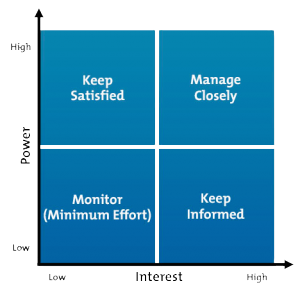 Explore ways to mitigate project risk by forging stronger connections with stakeholders.
Explore ways to mitigate project risk by forging stronger connections with stakeholders.
Have you ever championed a project at work only to see it fall apart? Or, as a hired project manager, have you failed to deliver and aren’t sure what happened?
As it turns out, stakeholder mismanagement is a big reason projects fail. But with better planning and communication, these costly failures can be avoided.
To help ensure that your next project is a success, we’ve outlined a communication-heavy approach advocated by the Project Management Institute. It’s a time-consuming, labor-intensive framework, but can actually save time and rack up wins.
Identify Stakeholders
Step one when managing a project is to identify stakeholders, basically anyone that can affect your project or be affected by it.
Stakeholders can be decision makers, community members, developers, or the CFO, anyone involved with the project. Arguably the most important stakeholder is the project sponsor, or the person who likely proposed and won budgetary support for the initiative. This person is invested in success, and can act as a project point person, project champion, and conflict resolver.
Ironically, the stakeholders that matter most — customers, for example — are often left out. This is where focus groups, A/B testing, and customer questionnaires can be useful.
Determine Communication Priorities
After you identify stakeholders, it’s time to figure out how much communication each stakeholder requires and why. This will save you time and let you focus your all-important communication efforts.
 To do this, we use an Interest and Power Grid. Plot each stakeholder based on their power to disrupt a project and their interest in the project.
To do this, we use an Interest and Power Grid. Plot each stakeholder based on their power to disrupt a project and their interest in the project.
Are you working on the pet project of the CEO? You’ll want to place her in the “Manage Closely” box. The CFO might be an example of “Keep Satisfied,” since she could cut the program if it goes over budget. An example of a “Keep Informed” stakeholder might be the customer service team that eagerly awaits a new tool but has no real power over the project development. Finally, “Monitor” might be your customers, who are not involved or have power over the project, but should be kept in mind.
Courtesy: www.mindtools.com
Evaluate Stakeholder Types
Now that you know where to focus your communication energies, the next step is to identify what type of stakeholder they are. Not all stakeholders are necessarily crossing their fingers for a project’s success; it could be quite the opposite.
In this framework, there are five types of stakeholders: Unaware, Resistant, Neutral, Supportive, and Leading.
Unaware stakeholders might be customers, while Resistant stakeholders could be someone who believes they will lose out if the project succeeds. Leading stakeholders are very involved, but also require close management since their high level of interest can actually lead to a disruptive amount of involvement.
Establish Learning Styles
Now that you know whom you’re dealing with, how much relative time to spend communicating with them, and their perspectives on the project, it’s finally time to start communicating.
Of course, not everyone “hears” in the same way. People learn in primarily one of three different ways: visual, auditory, and kinesthetic.
Entrepreneurs and salespeople are often auditory learners, preferring the fast-paced back-and-forth of phone call and in-person conversations. Engineers are often visual learners, as they typically like to read and think, so emails can be useful. Kinesthetic learners are not likely to absorb what you’re communicating until they can try it out for themselves, so think in terms of interactive examples and demos.
You can waste a lot of time and energy communicating with a stakeholder the wrong way, potentially imperilling your project. So be aware of your stakeholders preferred learning style.
For example, if a high-power, high-interest stakeholder is an auditory learner, expect to spend a lot of time on the phone. Do your engineers just need to stay abreast of the project? Consider regular one-directional “push” emails with updates. They’ll thank you for it!
Account for Politics
When possible, try to consider the political dynamics of your team. Is there anyone with a potential conflict of interest? Or perhaps the CEO is best friends with a low-power stakeholder, meaning that person’s opinions may carry more weight if they get discussed on the squash court.
This can be difficult for 3rd party consultants, so take your cues where you can. This is where the project sponsor can be of great help to you.
If you are an in-house project manager, look to past projects for insights and consider your company’s culture when attempting to account for politics within a project.
Set Up Communication Expectations
All the communication in the world won’t do you much good if there isn’t a process in place that outlines communication expectations. Reporting, budgets, timelines, meeting frequency, how issues are logged and escalated, target results, etc.
Keep in mind, if you have 8 people on a project—a low number by corporate standards—you have 28 separate communication channels! If all of these potential lines of communication aren’t part of an agreed upon process, chaos can ensue!
Manage Issues and Resolve Conflicts
Finally, and inevitably, conflicts will arise. Some serious, some less so.
Conflict resolution is a big part of project management, so to help you do your job, here are the five categories of resolution options: withdrawal/avoiding, smooth/accommodate, compromise/reconcile, force/direct, and collaborate/problem solve.
The ideal outcome is to collaborate and problem solve, where the project group discusses and solves an issue with you serving as the facilitator. But in an emergency, like a site crash, in the expedience of time you may need to use the force/direct approach, which is typically a win-lose decision.
If a problem is becoming distracting and can be tabled to be dealt with at a later, more suitable time, then withdrawal/avoiding might be your best bet. Smooth/accommodate can be useful when the problem isn’t necessarily serious, and obliging the aggrieved will cost little.
In each of these outlined steps, effective communication is the key theme. It’s not just how much you communicate, but to whom and how, as well.

